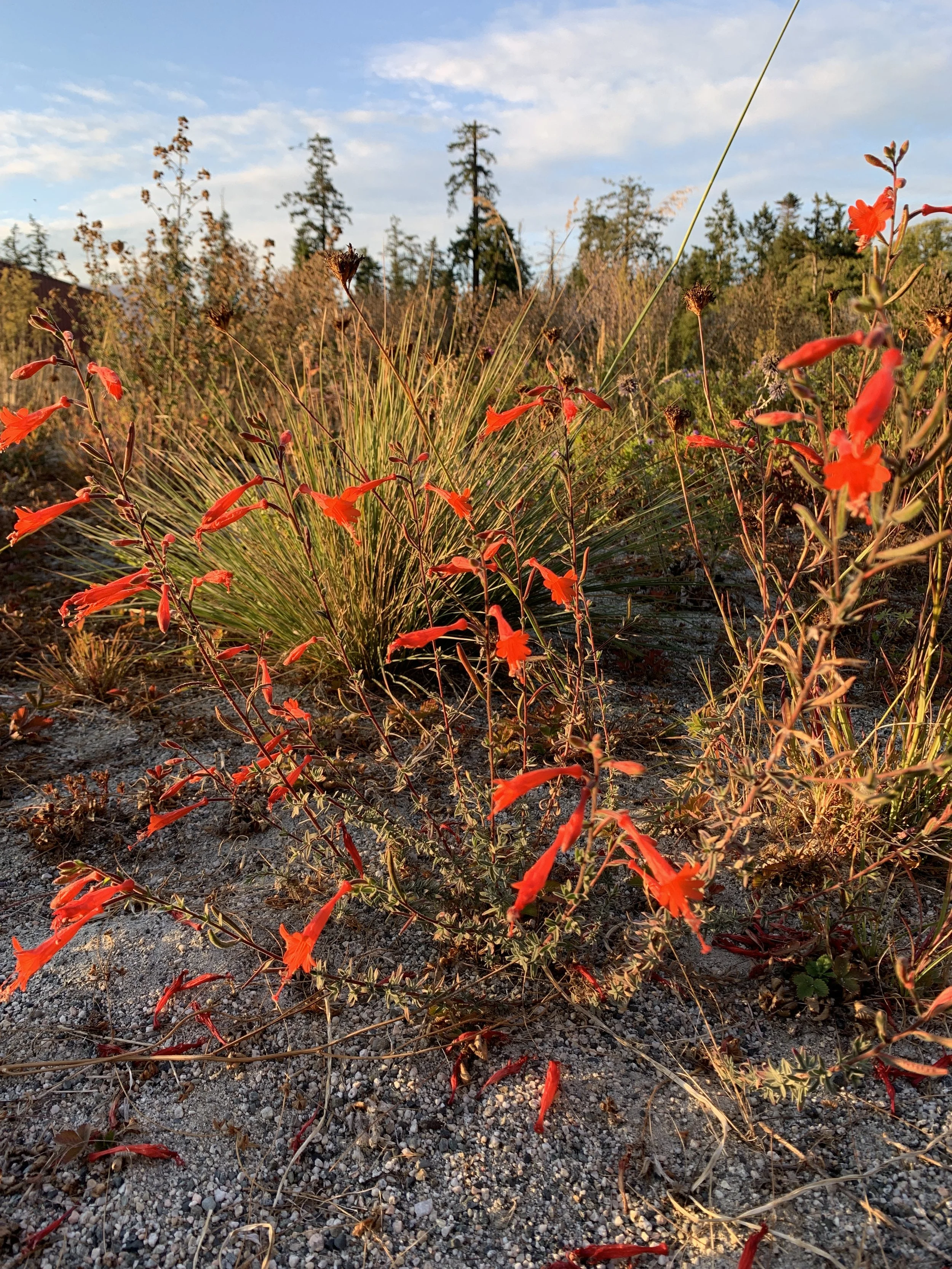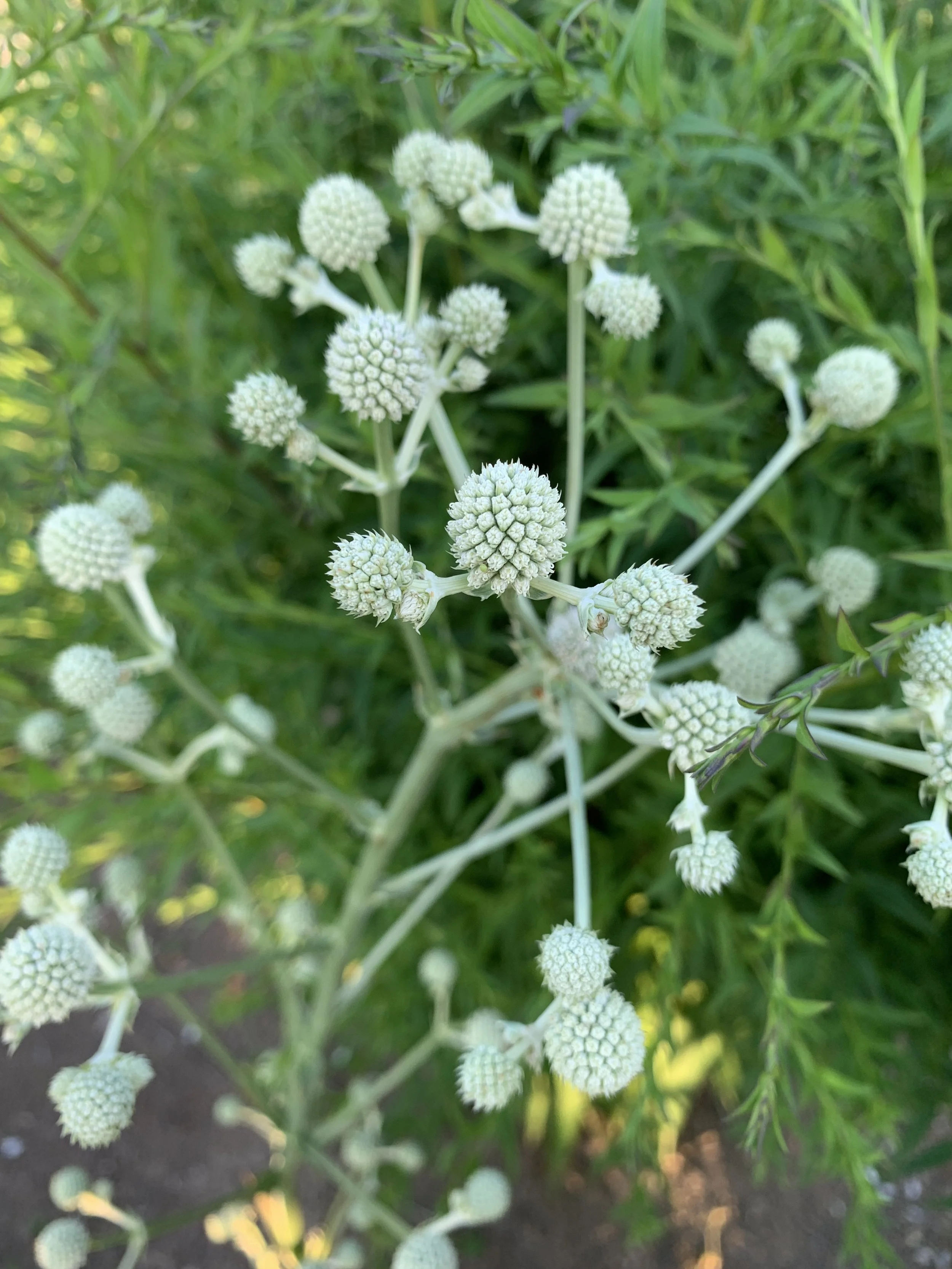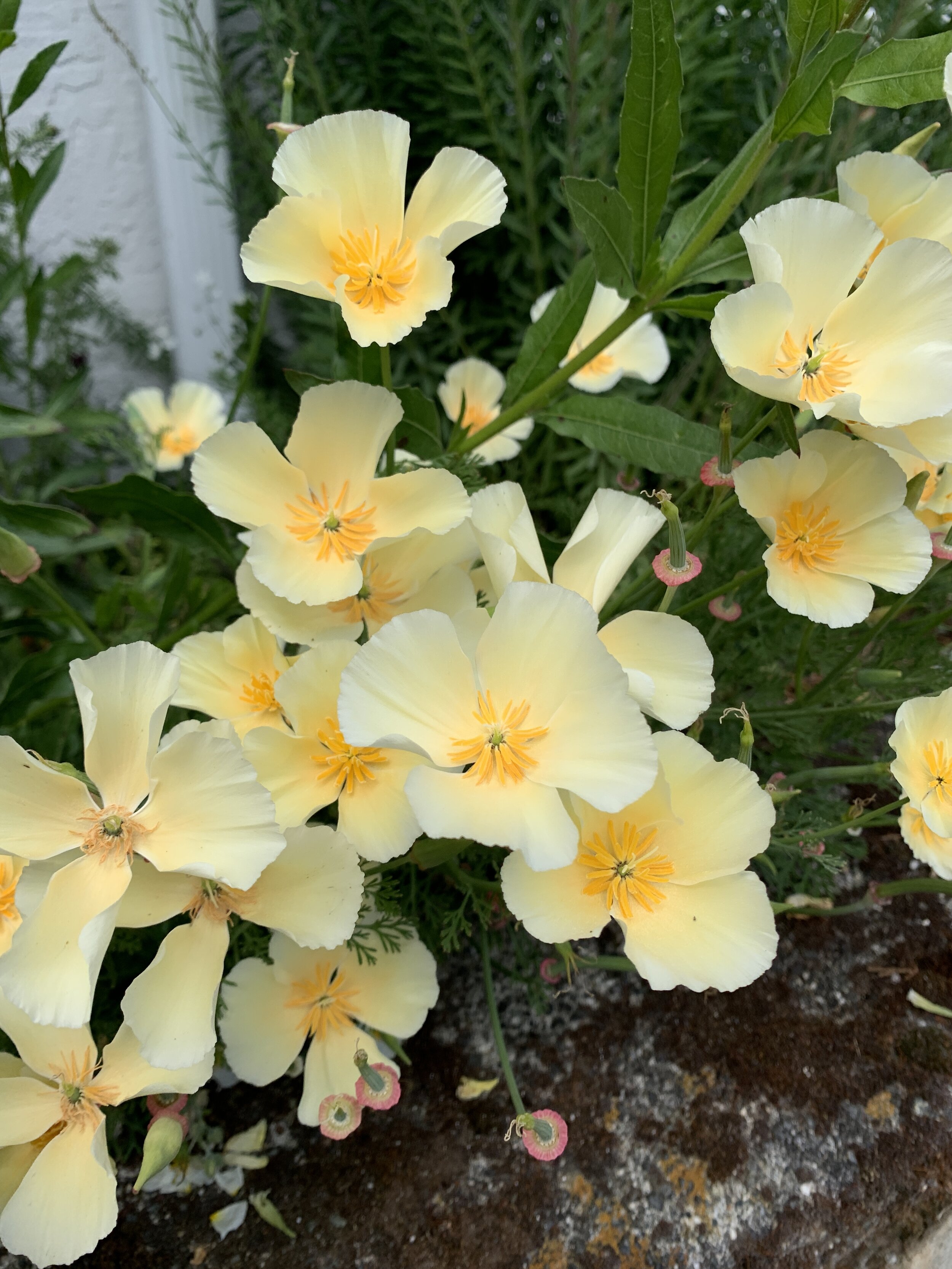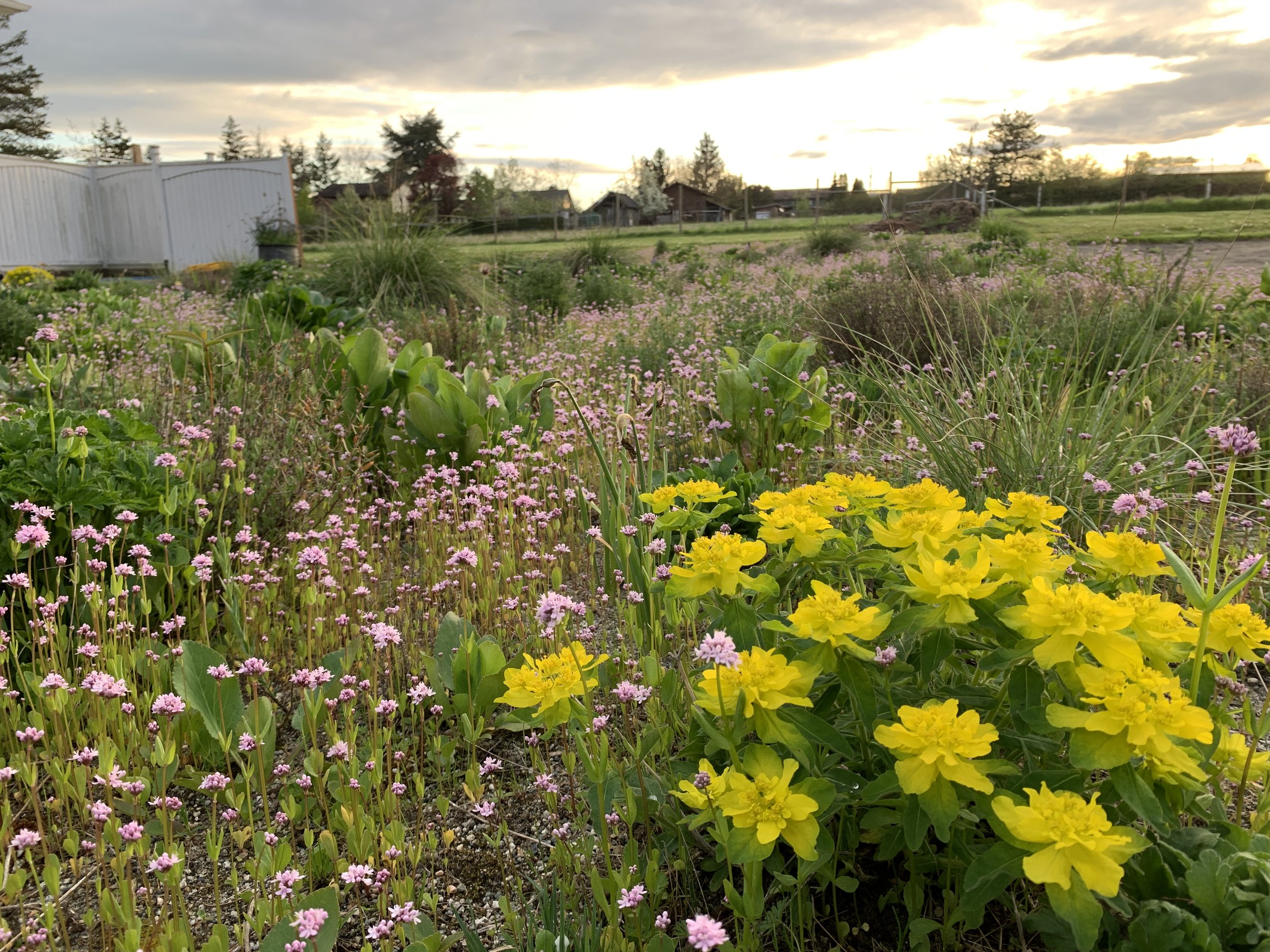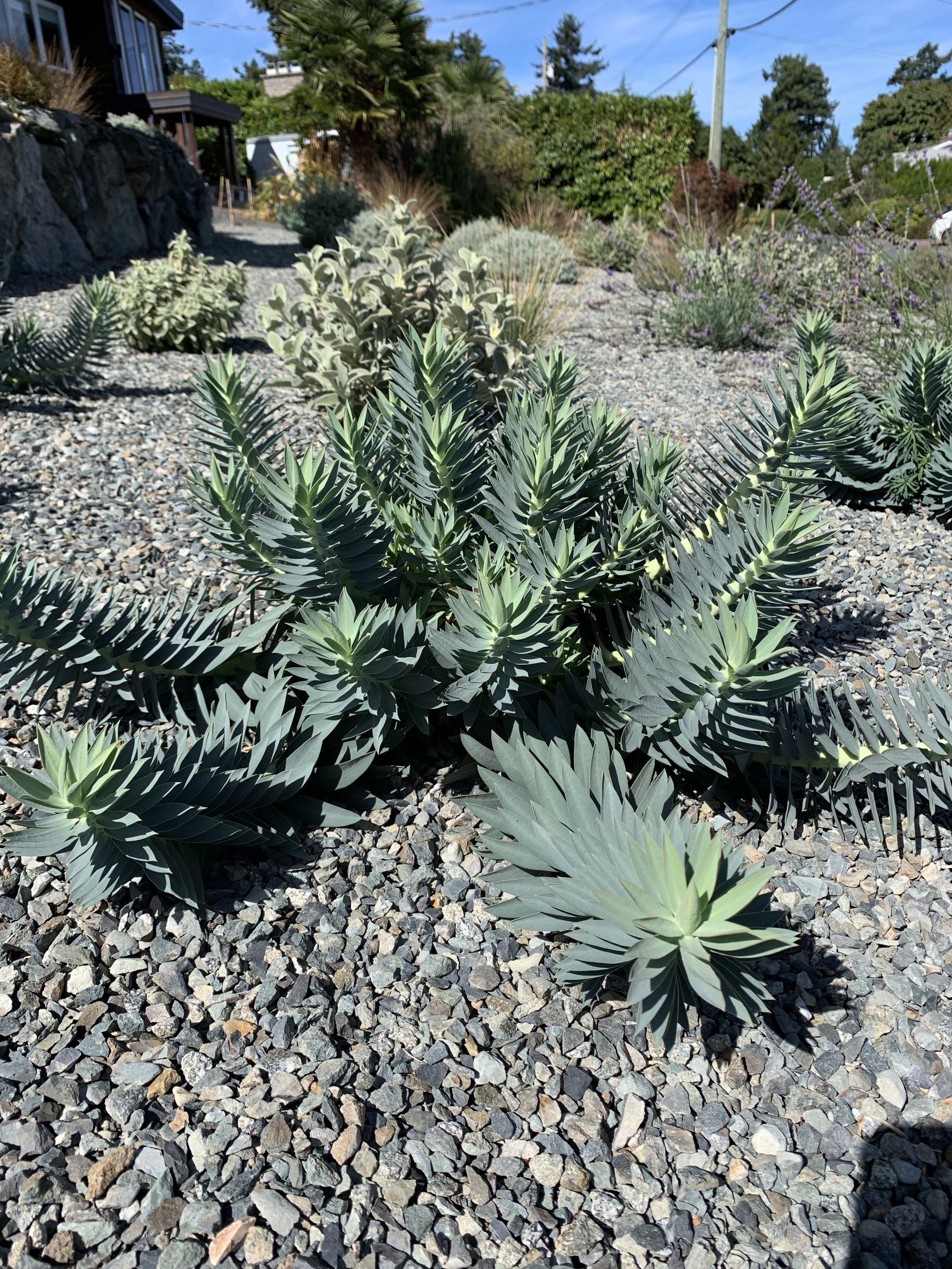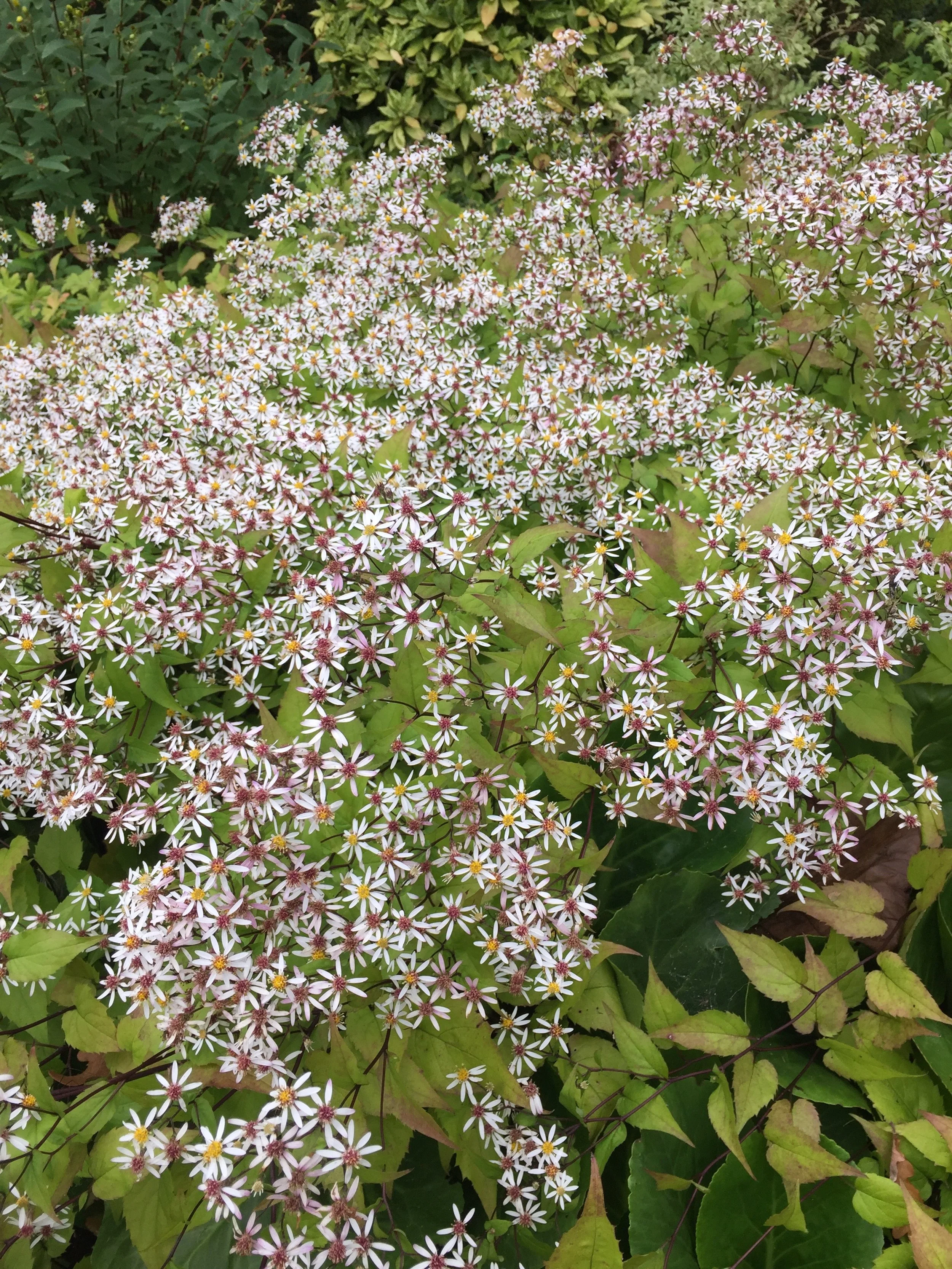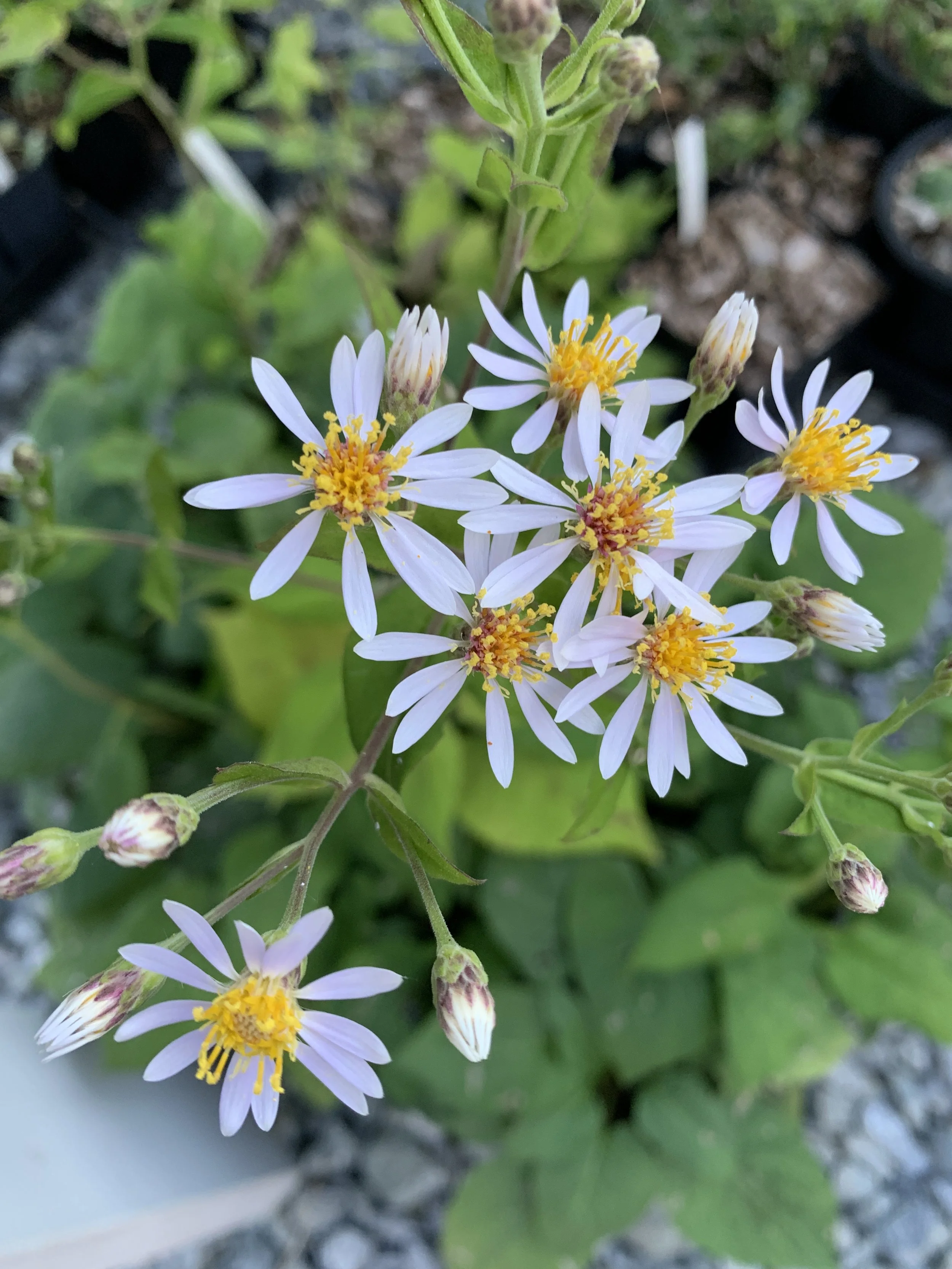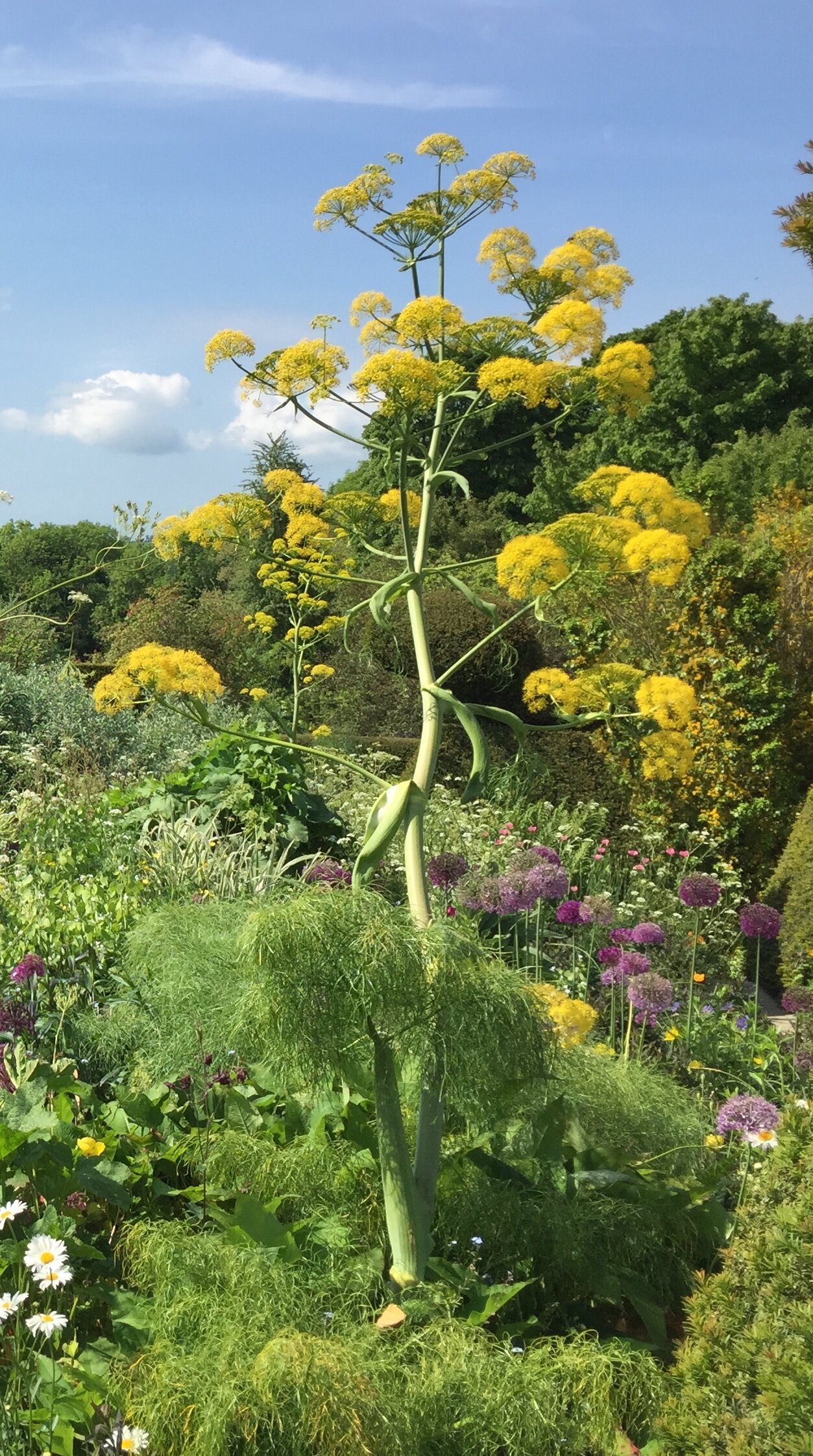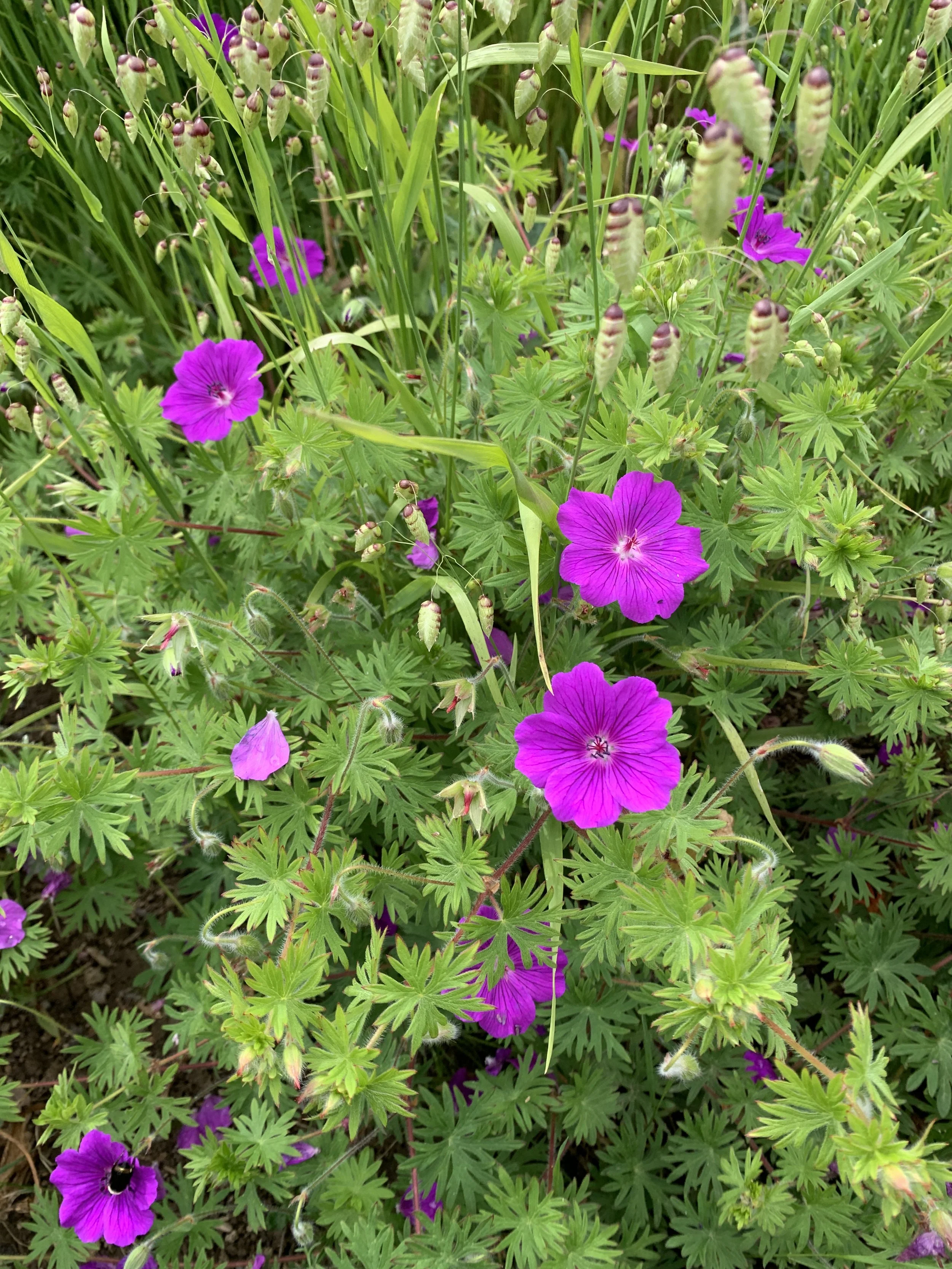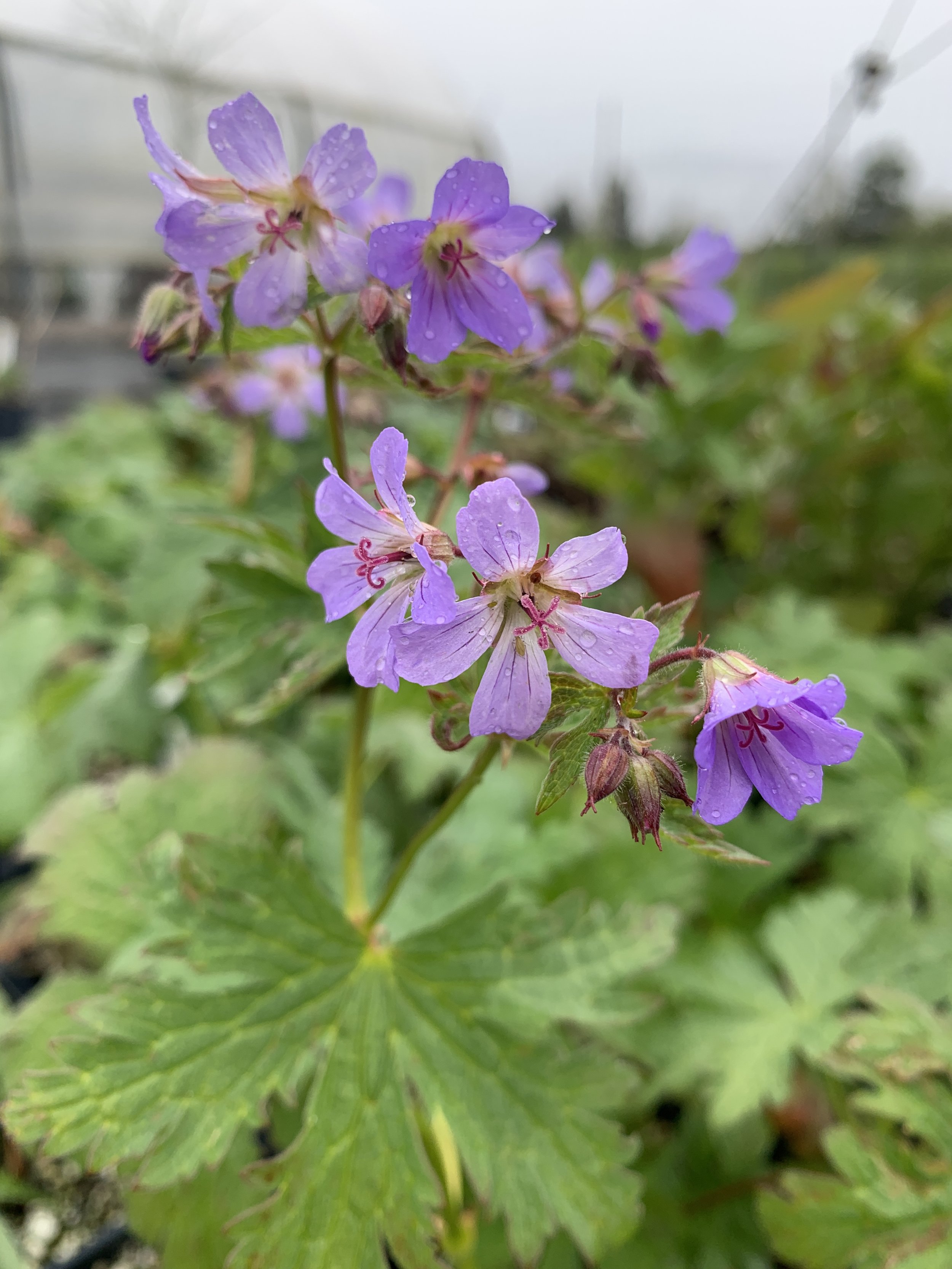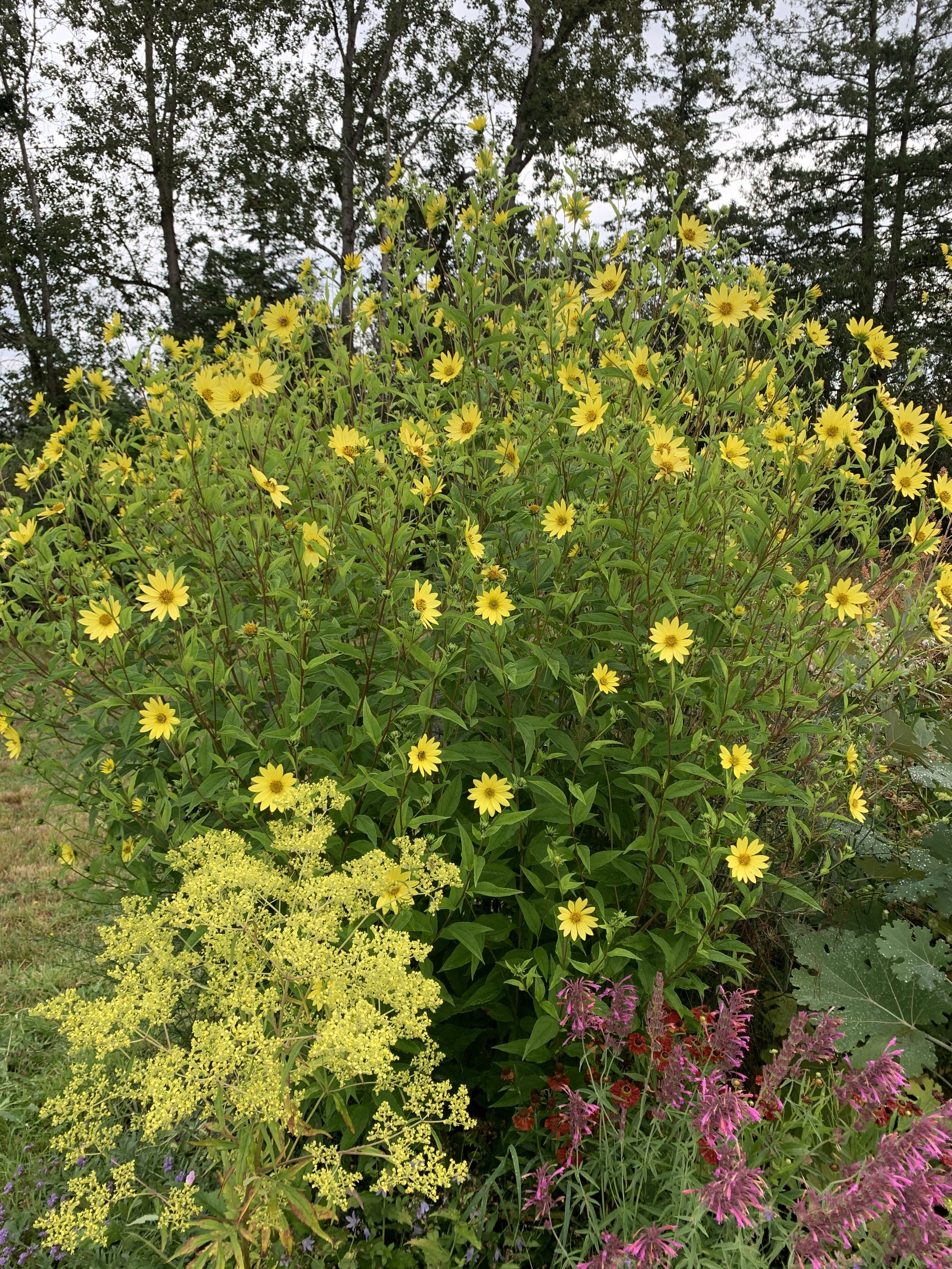Echinacea pallida - Flowers in early summer and needs little summer water. I like the drooping pink petals. Sun, low water, height to 90 cm.
Echinacea pallida ‘Hula Dancer’ - Pale pink to white petals droop from the center cone that is usually occupied by some pollinator or another. Slightly larger plant than the species. Sun to part shade, low water, height 60-90 cm.
Ellisiophyllum pinnatum - A vigorous groundcover if you can get it established. Super sweet white flowers in summer. Mostly evergreen although will die back in harsh winters. Needs summer water. Part to full shade, well-drained, height under 10 cm.
Epilobium angustifolium ‘Stahl Rose’ - A slightly more refined version of our native fireweed, this one has pale pink flowers. Runs underground vigorously, but doesn’t seem to self-sow. May go fully summer dormant under drought stress. Sun, low water, height 100-150 cm.
Epilobium canum - A hardy form of California Fuchsia with red tubular flowers. Photo is from September 2021 with no irrigation - impressive ability to flower with no water, but will look better with just a little additional summer water. Stick to poor soil unless you don’t mind it getting leggy (up to 1m tall with good soil and irrigation!) and spreading quickly. Sun, well-drained, low water, height 30 cm+.
Erigeron karvinskianus - Whether frothing down stone steps or spilling out onto a garden path, E. karvinskianus is a delightful profusion of white and pink daisies from April to November, accepting a brief pause in hot summers. Sun or part sun, drought tolerant, height 30 cm, spread 40 cm.
Erigeron ‘Sommerneuschnee’ - Long, narrow, bright white petals make this an exceptionally pretty daisy. Pink buds are also attractive. Can be used as a cut flower, and deadheading will encourage blooms all summer long. Sun, height 60 cm.
Eriogonum fasciculatum - A pretty little buckwheat for a dry, well-drained spot in the garden. Flowers in summer, in blushing cream. Sun, well-drained, drought tolerant, height 30-60 cm.
Eriophyllum lanatum - A beautiful native flower for the unirrigated garden, Woolly Sunflower flowers in early summer, but can be cut right back to highlight the cottony, silver foliage. This form comes from Erik Fleischer and we have not seen seedlings from it. Sun, drought tolerant, height 30-50 cm.
Erodium manescavii - Bright pink flowers in spring, and if given some summer water it will flower continuously until fall. Attractive, feathery green leaves. Sun, well-drained, drought tolerant, height 15-40 cm.
Erodium trifolium - Fuzzy, scented leaves that begin to grow with autumn rain and will carry on through the winter in a mild location. White flowers with pink blotches and veining in profusion from late winter into spring/early-summer. Goes summer dormant in drought but with a little summer water will keep its scented, green leaves. Self sows. Sun, well-drained, drought tolerant, height 20-40 cm.
Eryngium agavifolium - Glossy green foliage with soft saw-toothed edges. The rosettes are just as attractive, if not more so, than the off-white thimble-shaped flowers. Popular with pollinators as all eryngium are. Evergreen and long lived. Sun, well-drained, low water/drought tolerant, height of foliage to 25 cm, flowers to 120 cm+.
Eryngium alpinum - Very large blue flowers that are not really prickly to touch, despite their appearance. Unremarkable foliage, but the super showy flowers, beloved by pollinators, more than compensate. Will go summer dormant under drought stress. Sun to part sun, well-drained, drought tolerant, height 60-80 cm.
Eryngium amethystinum - A pale blue eryngium with small button flowers surrounded by spikes on branching stems. Long lived. Pollinators adore eryngiums. Sun, well-drained, drought tolerant, height 50-70 cm.
Eryngium bourgatii - A stand-out eryngium for its deeply divided and spiked leaves which are veined and speckled with pure white. Prickly blue flowers are held high above the distinctive rosette. While my fondness for the genus precludes ever gardening with just one, E. bourgatii is what I would recommend for those less enamoured. Prefers some summer water but can survive drought. More likely to be deer proof given how prickly it is. Can be used for cutting. Very perennial. Sun, well-drained, low water/drought tolerant, height 30-50 cm.
Eryngium eburneum - Clusters of white bobbles whorl around sturdy, upright stalks which can reach well over a meter as the plant matures. Foliage is pleasingly serrated and gradually mounds but isn’t very prickly. Long lived. Sun, well-drained, low water, height to 1m+.
Eryngium giganteum - The platonic ideal of an eryngium, perhaps thanks to the championing of horticulturalist Ellen Willmott. The flowers are perfectly proportioned with striking silver bracts. While vicious, it makes an ideal cut or dried flower. A biennial equally happy in a low water garden, a mixed border, or the bottom of a hedgerow. Best self-sown. Sun, low water, height 50-70 cm.
Eryngium maritimum - Beautifully waxy blue-green leaves form a spikey rosette from which rise blue-green flowers with broad bracts. Native to European beaches, it is a striking choice for a well-drained spot. Sun, well-drained, drought tolerant, height 50 cm.
Eryngium paniculatum - This slow growing eryngium forms a collection of spiky, serrated-leaf rosettes which send up towers of white bobble flowers. With regular summer water, flowering stems can reach 1.5m+, with less water the stems are shorter but still flowery. Pollinators love it. Bonus, the foliage is evergreen. Long lived. Sun, well-drained, low water, height of foliage to 40 cm, height of flowers from 1-1.5m+.
Eryngium planum ‘Blaukappe’ - Most E. planum varieties are short, but Jelitto bred this tall, intensely blue form that the bumblebees are obsessed with. I leave it standing into the winter because the birds eat the seed heads bare, and what gets missed self-sows, which is useful since these are not particularly long-lived plants (a few years under stress conditions). Great for cutting due to long stems. Soft, rounded leaves form a mostly evergreen rosette (so not really deer proof). Sun, drought tolerant, height 70 cm+.
Eryngium planum ‘Silver Salentino’ - Like ‘Blaukappe’ this is a seed strain from Jellito, which produces tall plants with silver button flowers. Likely to self-sow. Evergreen rosette. Pollinators adore. Sun, drought tolerant, height 120 cm.
Eryngium planum ‘White Glitter’ - I first grew this for cutting, and then figured I may as well throw a packet of old seed into the unirrirgated meadow for fun. It has thrived there, where the low stature and pure white bobbles make it pop amongst Dianthus carthusianorum and Limonium latifolium. I have not experienced it aggressively self-sowing in the way that E. planum ‘Blaukappe’ does in the same conditions, and it seems longer lived. Pollinator plant and can be used as a cut flower (fresh or dried). Soft, rounded leaves form a mostly evergreen rosette (so not one of the deer proof eryngiums). Sun, well-drained, drought tolerant, height 40 cm+.
Eryngium yuccifolium - A great mingler with interesting pale green foliage (yucca-like!!) and structural flowering stalks with white thimble flowers. Not as imposing as E. eburneum or E. paniculata, more apt to weave about amidst other things. Native to North American prairies. Will self-sow under favourable conditions. Pollinator plant. Somewhat prickly leaves so might be more unpalatable to deer than some, also helped by the fact it is often winter deciduous here. Needs some summer water. Long lived. Sun to part sun, well-drained, low water, height 1.2-1.5 m.
Eschscholzia californica ‘Alba’ - My seed originates from Beth Chatto’s gravel garden and thus shows itself as perfectly amongst acid euphorbias and shocking purple Verbena rigida in spring as dusty rose hylotelephium in fall. Wouldn’t be without it. Happily self-sows but seedlings are easy to pull out. Cut it back after it goes dormant in the summer and enjoy a new flush of foliage and flowers in autumn when cooler, moister weather returns. A short lived perennial in well-drained positions, otherwise annual. Sun, drought tolerant, height 30 cm.
Euphorbia epithymoides (syn. E. polychroma) - Makes a perfect dome of acid yellow flowers in spring. Under drought conditions it will shed its leaves by mid-summer, revealing attractive red stems. Sun to part shade, well-drained, drought tolerant, height 30-40 cm.
Euphorbia nicaeensis - Beautiful blue-grey leaves remain throughout the winter. I think the interesting buds and acid flowers really set off other spring and early summer bloomers. Very drought tolerant. Sun, drought tolerant, height 50 cm.
Euphorbia rigida - Legendary. Looks good in every season and could anchor an entire planting as a specimen or repeated throughout. Prefers poor, well-drained soil, and does best when allowed to self-sow. Flowers are lime-yellow spectacles in spring. Think of it as an oversized, upright E. myrsinites, where the pleasingly geometric, spiralling, blue-green foliage is perfect for admiring instead of prostrate on the ground and splashed with mud. Sometimes the flower bracts take on reddish tones in drought or cold stress and then it all looks even better. Seeds come from my own winter-hardy plants. Sun, well-drained, drought tolerant, height 50 cm and width at least as much if not more.
Photo of E. rigida in Claire’s wonderful gravel garden from Kara Delbrouck/Bilston Creek Horticulture.
Euphorbia schillingii - I like this summer-blooming euphorbia. It’s tall, the stems turn an attractive red as the season wears on, and it really does flower most of the summer. Pollinators like it. Clumping and I have not seen it self-sow in my garden, unlike many of the others. Does well in my heavy soil. Sun to part shade, low water, height 90 cm+.
Euphorbia segueriana - Very narrow stems of bluish green leaves mound outwards, flowering yellow at the tips in early summer. Sun, well-drained, drought tolerant, height 30-50 cm.
Eurybia divaricata - A lovely woodland-edge aster that I appreciated at Beth Chatto's, where it sprawled over bergenia and amongst epimedium. Glossy black stems and leaves that turn lime green in autumn help set off the white flowers. Needs very little summer water. Pollinators love it. Sun to shade, low water, height 75 cm.
Eurybia macrophylla - Forms a dense, rhizomatous groundcover of heart-shaped leaves, with white flowers in late summer/autumn. Part shade to shade, low water, height 30 cm.
Eurybia x herveyi ‘Twilight’ - Syn. Eurybia macrophylla ‘Twilight’ for good reason as it has similar heart-shaped leaves that form dense cover in spring, but ‘Twilight’ differs with pretty violet blue flowers held in flat disks in late summer/autumn. Prefers part shade and some summer moisture, but doesn’t need a lot. Will spread by rhizome when happy. Part shade to sun, low water, height 75-90 cm.
Ferula communis - Ferula communis is a converter plant, by which I mean that when it flowers (electric yellow), its presence (3 m tall) is so powerful and undeniable that it will entice small children, the plant blind, and your neighbours (who think you’re insane), to spend time in your garden. Is this a good thing? For you, maybe not. But for plants (and the planet) it is very good. We need more plants like Ferula communis which possess this power to enchant because they are so alien, so beyond what we imagine a garden plant can be, that they jolt us into connecting with the physical world right now. Will it take up an increasing amount of space each spring with frothy green foliage before going dormant in the summer? Yes. Do you have to wait several years for it to flower? Yes. Will it die after flowering? Usually. Should all responsible gardeners make room for some? Absolutely. Sun, prefers well-drained, mature foliage height around 80-90 cm with spread of the same, flower stalk anywhere from 2 - 4 m.
Ferula tingitana ‘Cedric Morris’ - A more diminutive ferula than F. communis, topping out at around 1 m, and with much glossier, stiffer foliage. A beautiful yellow umbel to add to the garden. These plants come from seed from Beth Chatto’s, and were originally collected by her friend and garden mentor Cedric Morris. Sun, well-drained, drought tolerant, mature foliage height around 50 cm with similar spread, flower stalk to around 1 m.
Francoa ramosa - This seed comes from Graham Smyth’s beautiful clump of plants, which show off through the summer in part shade. The leaves are quite coarse, rippled and long, but form neat-enough rosettes that don’t distract from the wands of pale pink flowers. Part shade to sun, well-drained, height 60-90 cm.
Genista aetnensis - Mount Etna Broom. A gorgeous shrub or small tree for the dry garden, with weeping green branches that cast no shade, and in summer are clothed with honey-scented, yellow pea flowers. Not picky about soil, but can be a little tender in the first few years. I have had good success overwintering in an unheated polytunnel for at least 2 years before planting out. I now have plants growing in several locations without irrigation on the property. I obtained seed originally from trees at Beth Chatto's (pictured) and locally from Joe Harvey, and now collect seed off my own established shrubs. Not invasive or known to self-sow in our conditions. Sun, well-drained, drought tolerant, eventual height to 8 m.
Geranium ‘Dilys’ - A cross between G. sanguineum x G. procurrens. Small flowers from summer into autumn. I love this plant for the intricate foliage, which takes on great autumn colour, and how it weaves through surrounding plants to give little pops of purple. Seen here scrambling amongst Seseli hippomarathrum. Clump-forming. Deer resistant. Sun, low water, height 15 cm+.
Geranium ‘Khan’ - Medium size magenta flowers begin in early summer and carry on sporadically through the growing season. The foliage colours beautifully in the fall. Deer resistant. Vigorous, wonderful! Sun to part shade, low water, height 30 cm.
Geranium ‘Orion’ - A dazzlingly large geranium with nice blue-violet flowers. Has an AGM for good reason! Flowers in early summer and can be cut back for a second flush. Deer resistant. Sun, height 80 cm, width 80 cm.
Geranium ‘Prelude’ - This cross of G. albiflorum x G. sylvaticum has small mauve flowers in clusters and will look right at home in a slightly wild woodland border. Eventually forms a lush mound smothered in delicate flowers. Can be cut back after flowering to refresh. Deer resistant. Part shade to shade, height 40-60 cm.
Geranium ‘Sirak’ - An AGM geranium with pink flowers in early summer and a clumping habit. Deer resistant. Sun, height 40-50 cm, width to 60 cm.
Geranium himalayense ‘Derrick Cook’ - Large, purple-veined, white flowers in early summer. Exactly my kind of geranium: generously groundcovering but not aggressive. Sun to part shade, low water, well-drained, height 50 cm.
Geranium macrorrhizum ‘White Ness’ - Purest white flowers over apple green leaves. Useful as a groundcover. Sun to shade, low water, height 25 cm.
Geranium palmatum - Simply lovely, especially after a mild winter in part shade and moist conditions. Don't remove too many dead leaves as they help prop the plant up. Part shade to sun, height and spread to 90 cm.
Geranium phaeum ‘Mierhausen’ - Pale purple blooms begin in late spring and continue sporadically through the summer. Small purple markings on leaves. Needs some summer water and prefers better soil. Deer resistant. Part shade to shade, low water, height 50 cm.
Geranium sanguineum ‘Album’ - Good, green foliage forms an open mound or weaves through plants at the front of the border. Pure white flowers in late spring through summer. Deer resistant. Sun to part sun, low water, height 30 cm.
Geranium sanguineum ‘Apfelblüte’ - Can’t have too many G. sanguineum, sorry. This one is a softer pink than var. striatum, and a bit slower growing. Selected by Ernst Pagels. Deer resistant. Sun to part shade, low water, height 25-30 cm.
Geranium sanguineum ‘Cedric Morris’ - Bright purple flowers and an upright habit. Collected by Cedric Morris and introduced by Beth Chatto Gardens (so of course I grow it!). Bees like it; deer resistant. Sun to part shade, low water, height 40 cm.
Geranium sanguineum var. striatum - A very pretty pink geranium with dark pink stripes. Classic sanguineum leaves and low mounding habit. Flowers all summer with just a little water! Deer resistant. Sun to part shade, low water, height 25 cm.
Geranium sylvaticum ‘Immaculee’ - A pretty white-flowered form of the wood cranesbill. Flowers in late spring to early summer. Deer resistant. Sun to part shade, height 40-50 cm.
Geranium x magnificum - Large, velvety, violet-blue flowers grace this plant for only a few weeks but it is a ‘wow’ moment. The rest of the year the dark green foliage provides nice texture and colours up well in autumn. Deer resistant. Sun to part shade, height to 60 cm.
Geum ‘Herterton Primrose’ - These do so well on my heavy clay soil, even under low water conditions, and they flower for a remarkably long time, from spring well into summer. Pollinators like them and I do too. Yellow, drooping flowers with red calyx. Evergreen foliage in mild winters. Will quickly form a sizeable clump. Full sun to part shade, height 45 cm.
Geum ‘Leonard’s Variety’ - These do so well on my heavy clay soil, even under low water conditions, and they flower for a remarkably long time. Rich pink with darker calyces. Pollinators like it. Sun to part shade, height 35-40 cm.
Geum triflorum - In a well-drained spot, Geum triflorum has the sweetest spring/early summer blooms and seed puffs, both pale pink. If happy, it will form a nice mat. Sun, well-drained, drought tolerant, height to 30 cm.
Gillenia trifoliata - One of those perennials that was the star of my garden in Alberta and I would not be without it here, and yet it remains relatively rare in the trade. Starry white flowers in June with attractive red calyxes that linger on the plant. Beautiful foliage. Needs regular summer water. Sun to part shade, height 1 m.
Glaucium flavum - Ruffly, grey-green leaves and yellow flowers are overwhelmed towards the end of the summer by a cyclone of long, curved seed pods. Sun, well-drained, drought tolerant, height 30 cm.
Goniolimon incanum ‘Sea Spray’ - Tiny white flowers form a paddle shape, held stiffly aloft over an unassuming rosette of dark green leaves. Sun, well-drained, drought tolerant, height 20 cm.
Helenium ‘Loysder Wieck’ - A unique selection of helenium with orangey-red petals that curl inwards to create a spiky looking flower. Good for cutting. Always popular with pollinators! Sun, height 90 cm+.
Helianthus ‘Lemon Queen’ - Great late summer colour in my favourite shade of yellow. Flowers from mid-summer until frost. Pollinator fav. Good cut flower. Does fine with low water on my heavy soil and as a bonus when grown this way does not spread aggressively or need staking. With richer soil and more water you may need to divide it more frequently to keep it check. I only divide mine every few years. Sun, height 1.6-1.8 m.
Helianthus orgyalis - H. orgyalis is sturdy and tall, with characteristic yellow daisy flowers opening in August and September. Bees love it. The foliage is wider and coarser than H. salicifolius, but still ‘willowy.’ It’s unclear whether this is just a (superior) form of H. salicifolius or a separate species, but this came to me as H. orgyalis and I like it so much better than H. salicifolius, which tends to flop. Low water in water-retentive, heavy soil, otherwise will need more regular summer water. Sun, low water, height 2m+.
Helichrysum thianschanicum - Tight clusters of yellow flowers, useful for dried flower arrangements. Attractive silvery foliage which can also be used for cutting. Sun, drought tolerant, well-drained, height 30 cm.
Heuchera villosa - I don’t have much time for the fancy-leaved heuchera hybrids and selection. But the first time I saw this big, frothy species H. villosa, with its pretty apple green leaves, I knew I would be planting it everywhere in the garden. It’s a great doer, doesn’t steal the show but lightens the picture, and the bees enjoy it. Sun to shade, low water, height of foliage 30-40 cm, flowers 70-90 cm.
Hyssopus officinalis ssp. aristatus - Fabulous hyssop for the dry garden that forms a low mound. Late summer flowering, bees love it, aromatic foliage… what more could you want! I clip it back in late winter into a mounding shape. Probably deer resistant. Sun, well-drained, drought tolerant, height 40 cm.
Isodon umbrosus - An interesting foliage plant for the shade garden, but truly earns its keep in August and September when small lavender blue tubular flowers suddenly clothe the long stems. Part shade to sun, moist, well-drained, height 100-150 cm.
Jasione laevis - From narrow-leafed rosettes rise thin stalks holding blue bobble flowers. Flowers through most of the summer. Cute! Does best with a few waterings over the summer. Pollinators like it. Sun, well-drained, low water, height to 40 cm.





